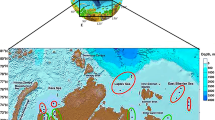Abstract
The abundances of virioplankton and planktonic picocyanobacteria in deep and shallow water sites of Rybinsk Reservoir during the freezing period (water temperature 0.3–0.9°C) varied from (37.1 to 84.1) × 106 ((57.3 ± 2.1) × 106, on average) particles/ml and from 13.5 to 75.0 × 103 ((48.7 ± 3.4) × 103, on average) cells/ml, respectively. The fraction of picocyanobacteria with viruses attached to their cell surface was 6.5–29.0% (12.0 ± 0.8%, on average). The proportion of visible infected cells was 0.7–7.6% (2.2 ± 0.3%, on average) of the numbers of picocyanobacteria. It is likely that viruses play an important role in the regulation of picocyanobacteria abundance during the freezing period.
Similar content being viewed by others
REFERENCES
Callieri, C. and Stockner, J.G., Freshwater autotrophic picoplankton: a review, J. Limnol., 2002, vol. 61, no. 1, pp. 1–14.
Kopylov, A.I., Kosolapov, D.B., Zabotkina, E.A., and Strashkrabova, V., Distribution of Picocyanobacteria and virioplankton in mesotrophic and eutrophic reservoirs: the role of viruses in mortality of Picocyanobacteria, Biol. Bull. (Moscow), 2010, vol. 37, no. 6, pp. 565–573.
Maclsaac, E.A. and Stockner, J.G., Enumeration of phototrophic picoplankton by autofluorescence microscopy, in Handbook of Methods in Aquatic Microbial Ecology, Boca Raton, FL: Lewes Publishers, 1993, pp. 187–197.
Mann, N.H., Phages of the marine cyanobacterial picophytoplankton, FEMS Microbiol. Rev., 2003, vol. 27, no. 1, pp. 17–34.
Mikheeva, T.M., Piko- i nanofitoplankton presnovodnykh ekosistem (Pico- and Nanophytoplankton of Freshwater Ecosystems), Minsk: Belorus. Gos. Univ., 1998.
Noble, R.T. and Fuhrman, J.A., Use of SYBR green for rapid epifluorescence count of marine viruses and bacteria, Aquat. Microb. Ecol., 1998, vol. 14, no. 2, pp. 113–118.
Proctor, L.M. and Fuhrman, J.A., Viral mortality of marine bacteria and cyanobacteria, Nature, 1990, vol. 343, pp. 60–62.
Stockner, J.G., Autotrophic picoplankton in freshwater ecosystems: the review from the summit, Int. Rev. Hydrobiol., 1991, vol. 76, no. 4, pp. 483–493.
Suttle, C.A., Cyanophages, in The Ecology of Cyanobacteria: Their Diversity in Time and Space, Whitton, B.A. and Potts, V., Eds., Dordrecht: Kluwer Academic, 2000, pp. 563–589.
Author information
Authors and Affiliations
Corresponding author
Additional information
Translated by D. Pavlov
Rights and permissions
About this article
Cite this article
Kopylov, A.I., Kosolapov, D.B. & Zabotkina, E.A. Viral Infection of Picocyanobacteria in the Rybinsk Reservoir During the Freezing Period. Biol Bull Russ Acad Sci 45, 1159–1164 (2018). https://doi.org/10.1134/S1062359018100163
Received:
Published:
Issue Date:
DOI: https://doi.org/10.1134/S1062359018100163



